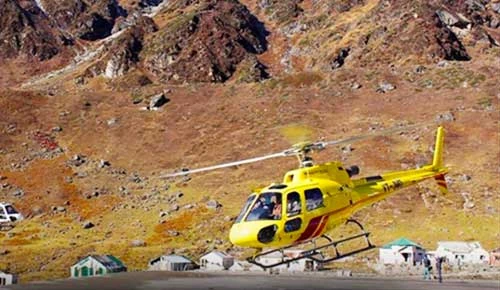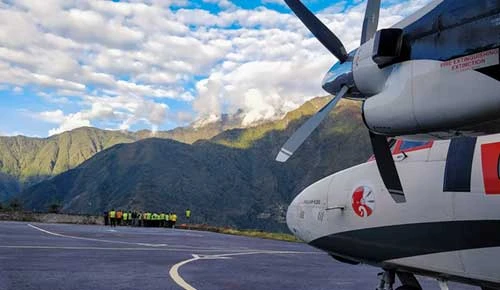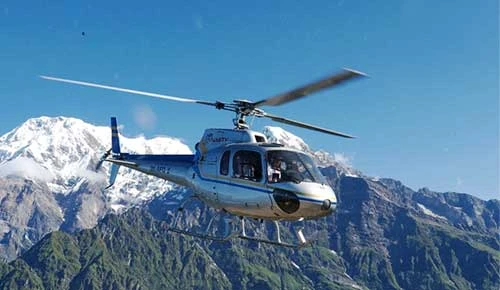EBC Helicopter Tour During Winter Season
In the heart of the majestic Himalayas, an Everest Bas camp helicopter tour offers an extraordinary journey into the breathtaking beauty of the world's tallest peaks. While this adventure is already a remarkable experience, doing it during the winter season adds an enchanting layer to the expedition.
Picture snow-covered landscapes, crystal-clear views of Everest and its neighboring summits, and the tranquility of a winter wonderland.
In this blog, we delve into the captivating world of the Everest helicopter tour in winter, exploring the unique charm that the colder months bring to this already awe-inspiring adventure. Whether you're an avid traveler seeking a new and unforgettable experience or simply curious about the magic of the Himalayas in winter, join us as we unravel the reasons why a winter helicopter tour to Everest is a must-consider expedition.

Table of Contents
Magic of Winter During Everest Helicopter Tour:
Choosing to experience the Everest helicopter tour in winter comes with a unique set of reasons that add a special touch to the adventure.
- Region transforms into a snowy paradise with majestic peaks and valleys covered in snow.
- Frozen lakes and rivers enhance the scenic beauty.
- Winter brings clear skies and less cloud cover.
- Unparalleled visibility of Everest and nearby peaks
- Fewer tourists come in winter for a more peaceful experience.
- Participants enjoy tranquility without large crowds.
- Reduced tourists allow for a more personalized experience.
- Guides and pilots focus on individuals needs.
- Unique lighting conditions enhance snow-covered landscapes.
- Ideal for capturing stunning images.
- Winter adds an adventurous atmosphere to the tour.
- Participants experience the Himalayas in a less-explored state.
- Snow-covered landscapes create a surreal and unforgettable journey.
Challenges of Winter Heli Tours in the Everest Region
While a winter helicopter tour of Everest Base Camp offers a spectacular experience, there are notable challenges to consider:
- Unpredictable winter weather, including sudden snowstorms and high winds, may impact helicopter flights.
- Extremely cold temperatures, well below freezing, pose challenges for passengers and equipment, requiring proper insulation and maintenance.
- Shorter winter days limit the available daylight for helicopter tours, affecting scheduling and duration.
- High altitude in the Everest region requires awareness of potential altitude-related issues, especially with rapid changes in elevation during helicopter flights.
- Narrower windows for flights due to weather constraints and reduced daylight hours, leading to a more condensed itinerary.
- Snow and ice make landing areas challenging, requiring careful selection by pilots for safety and stability.
- Cold temperatures can impact helicopter performance, necessitating proper maintenance for safe operation in winter conditions.
- Snow and freezing temperatures may affect communication systems, emphasizing the need for reliable communication between the helicopter crew, base, and emergency services.
- Fewer visitors in winter may result in limited facilities and services, requiring careful planning for essentials like fuel, accommodations, and emergency support.
- Increased risk of avalanches in winter requires pilots and operators to stay updated on avalanche risk and choose safe flight paths.
Table Summarizing Pros and Cons of Everest Helicopter Tour in Winter
Pros of Winter Heli Tour | Cons of Winter Heli Tour |
Snowy Paradise: The region transforms into a magical snowy paradise. | Unpredictable Weather: Sudden snowstorms and high winds can impact flights. |
Enhanced Scenery: Majestic peaks, valleys, frozen lakes, and rivers covered in snow add to the scenic beauty. | Extremely Cold Temperatures: Below-freezing temperatures require proper insulation for passengers and equipment. |
Clear Skies: Winter brings clear skies and less cloud cover, offering unparalleled visibility of Everest and nearby peaks. | Shorter Days: Limited daylight affects scheduling and the duration of helicopter tours. |
Peaceful Experience: Fewer tourists result in a more peaceful and personalized experience. | Altitude Challenges: High altitude requires awareness of potential altitude-related issues. |
Tranquility: Participants enjoy tranquility without large crowds, enhancing the overall experience. | Narrower Flight Windows: Weather constraints and reduced daylight hours lead to a more condensed itinerary. |
Personalized Experience: Guides and pilots can focus on individual needs due to reduced tourist numbers. | Challenging Landing Areas: Snow and ice make landing areas challenging, requiring careful pilot selection. |
Unique Lighting Conditions: Winter's unique lighting enhances the beauty of snow-covered landscapes. | Impact on Helicopter Performance: Cold temperatures can impact helicopter performance, requiring proper maintenance. |
Ideal for Photography: Winter provides an ideal setting for capturing stunning images. | Communication Challenges: Snow and freezing temperatures may affect communication systems, emphasizing the need for reliability. |
Adventurous Atmosphere: Winter adds an adventurous atmosphere to the tour. | Limited Facilities: Fewer visitors may result in limited facilities and services, requiring careful planning. |
Less Explored State: Participants experience the Himalayas in a less explored state. | Avalanche Risk: Increased risk of avalanches in winter requires careful route selection. |
Safety and Environmental Considerations
Safety and environmental considerations are crucial aspects when embarking on an Everest helicopter tour in the winter. Ensuring the well-being of participants and minimizing ecological impact are integral to the overall success of the journey.
- Prioritize clear weather conditions for safe helicopter flights.
- Be aware of the potential challenges posed by the winter weather and take the necessary precautions.
- Choose a reputable tour operator with a focus on safety measures.
- Ensure experienced pilots and well-trained staff are part of the tour team.
- Familiarize participants with emergency protocols, communication plans, and evacuation procedures.
- Embrace leave-no-trace principles to minimize environmental impact.
- Encourage responsible behavior to preserve the natural beauty of the Himalayas.
- Respect local communities and adhere to cultural customs.
- Promote sustainable tourism practices for the long-term preservation of the region.
- Educate participants on the fragility of the ecosystem and the importance of responsible tourism.
Exploring the Options: Types of Winter Heli Tours
Winter helicopter tour to Everest base camp come in various forms, each catering to distinct preferences and budgets. Here's a breakdown of the primary options:
Standard Helicopter Tour
This is the most common and affordable option, offering a brief yet breathtaking aerial journey to Everest Base Camp. Participants enjoy panoramic views of the snow-capped Himalayas and iconic peaks, spending approximately 30 minutes at the base camp before returning to Lukla.
Extended Helicopter Tour
For those seeking a more immersive experience, the extended helicopter tour provides a longer duration at Everest Base Camp, allowing for deeper exploration and appreciation of the surroundings. Participants may also have the opportunity to visit Kala Patthar, a renowned viewpoint offering unparalleled vistas of Mount Everest.
Customized Helicopter Tour
For those with specific interests or requirements, customized helicopter tours can be arranged, tailoring the itinerary and activities to individual needs and preferences. This may include extended stays at specific locations, wildlife spotting excursions, or cultural immersion experiences provided through Nepal Trek Adventure .
Conclusion
In conclusion, a winter Everest Base Camp Helicopter Tour promises a unique and unforgettable adventure, showcasing the Himalayas in a breathtaking winter wonderland. Despite challenges like unpredictable weather and limited ground time, the opportunity to witness Everest's splendor from a different perspective, coupled with the tranquility of the season, makes it a truly magical experience. As you bid farewell to Lukla and the towering peaks, the memories forged during this brief yet extraordinary journey are sure to linger, celebrating the unparalleled beauty of the Everest region in winter.








